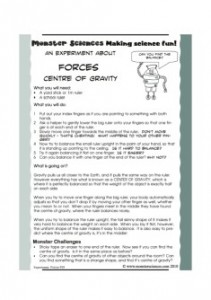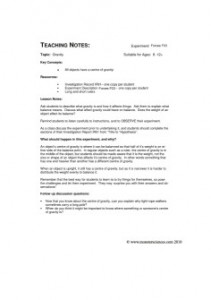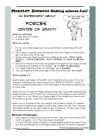A simple but effective investigation into the concept of the center of gravity which helps children understand how gravity works.
 |
 |
What you will need:
- A yard stick or 1m ruler
- A school ruler
What you will do:
- Put out your index fingers as if you are pointing to something with both hands.
- Ask a helper to gently lower the big ruler onto your fingers so that one finger is at each end of the ruler.
- Slowly move one finger towards the middle of the ruler, Don’t move quickly – that’s cheating! What happens to your other finger?
- Now try to balance the small ruler upright in the palm of your hand, so that it is standing up pointing to the ceiling. Is it hard to balance?
- Try it again balancing it flat on one finger. Is it easier?
- Can you balance it with one finger at the end of the ruler? Why Not?
What is going on?
Gravity pulls us all closer to the Earth, and it pulls the same way on the ruler. However everything has what is known as a CENTER OF GRAVITY, which is where it is perfectly balanced so that the weight of the object is exactly half on each side.
When you try to move one finger along the big ruler, your body automatically adjusts so that you don’t drop it by moving your other finger as well, whether you mean to or not. When your fingers meet in the middle they have found the centre of gravity, where the ruler balances nicely.
When you try to balance the ruler upright, the tall skinny shape of it makes it very hard to balance the weight on each side. When you lay it flat, however, the uniform shape of the ruler makes it easy to balance. It is also easy to predict where the centre of gravity is, it’s in the middle!
Monster Challenges:
- Sticky tape an eraser to one end of the ruler. Now see if you can find the centre of gravity. Is it in the same place as before?
- Can you find the centre of gravity of other objects around the room? Can you find something that is a strange shape, and find it’s centre of gravity?
Teaching Notes:
Topic:
Gravity
Key Concepts:
All objects have a centre of gravity
Resources:
- Investigation Record IR01– one copy per student
- Experiment Description Forces F03– one copy per student
- Long and short rulers
Lesson Notes:
Ask students to describe what gravity is and how it affects things. Ask them to explain what balance means. Discuss what affect gravity could have on balance. Does the weight of an object affect its balance?
Remind students to listen carefully to instructions, and to OBSERVE their experiment.
As a class discuss the experiment prior to undertaking it, and students should complete the sections of their Investigation Report IR01 from ”Title to “Hypothesis”.
What should happen in this experiment, and why?
An object’s centre of gravity is where it can be balanced so that half of it’s weight is on either side of the balance point. In regular objects such as a ruler, the centre of gravity is in the middle of the object, but students should be made aware that it is the weight, not the size or shape of an object that affects it’s centre of gravity. In other words something that has one end heavier than another has a different centre of gravity.
When an object is upright, it still has a center of gravity, but as it is narrower it is harder to distribute the weight evenly to balance it.
Remember that the best way for students to learn is to try things for themselves, so pose the challenges and let them experiment. They may surprise you with their answers and observations!
Follow up discussion questions:
- Now that you know about the centre of gravity, can you explain why tight-rope walkers sometimes carry a long pole?
- When do you think it might be important to know where something or someone’s centre of gravity is?



